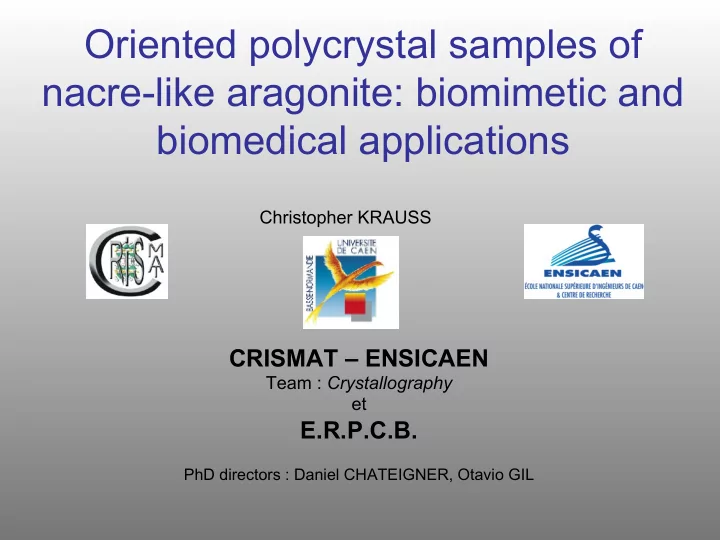

Oriented polycrystal samples of nacre-like aragonite: biomimetic and biomedical applications Christopher KRAUSS CRISMAT – ENSICAEN Team : Crystallography et E.R.P.C.B. PhD directors : Daniel CHATEIGNER, Otavio GIL
Map Ø Aims of this study Ø CaCO 3 : why aragonite ? Ø Techniques Ø Results Ø Outlooks 2
Aims of study • synthetic nacre for osteopathy natural nacre is highly osteoinductive prostheses mainly in titanium medical european law: forbids animal proteins in human body • Electrodeposition of CaCO 3 in aragonitic form on titanium • Caracterization of obtained microstructures and textures : SEM backscattering X-Ray diffraction 3
CaCO 3 : 3 allotropic forms • Calcite (R3c - trigonal) : too much stable form non-osteoinductive • Vaterite (P6 3 /mmc - hexagonal) : non-stable form too much for applications • Aragonite (Pmcn - orthorhombic) : metastable form Δ G 0 (C->A) = -1kJ/mol 4
Nacre: natural Aragonite microstructure Nacre composition: aragonite and organic phases (2% – 5%) Pinctada maxima Aragonite Acidic Macromolecules Silk-fibroin-like proteins β -chitin 5
Techniques: Electrochemical deposition Potentiostat Titanium working Saturated calomel electrode (foil) reference electrode Artificial see-water Platinium counter electrode electrolyte ( ASTM-D1141 strd ): (grate) NaCl ; Na 2 SO 4 ; MgCl 2 ; CaCl 2 ; KCl ; NaHCO 3 6
Electrochemical deposition Chemical reaction: • O 2 + 2H 2 O + 4e - 4OH - Highly negatif potentials water reduction: • 2H 2 O + 2e - 4OH - + H 2 • NaHCO 3 Na + + HCO 3 - • CaCl 2 Ca 2+ + 2Cl • HCO 3 - + OH - CO 3 2- + H 2 O • Ca 2+ + CO 3 2- CaCO 3 7
Employed techniques: Texture analysis • 4-Circles diffractometer for combined analysis • Texture program : MAUD • Rietveld refinement: Texture index F ² , film thickness … y i calc = y i background + ∑ S φ ∑ j φ h Lp h P φ h ( y ) [F φ h ] ² Ω φ h with h =[hkl]* P φ h ( y ) = preferred orientation correction factor 8
• • Magnesic calcite less stable that aragonite Excluding vaterite and calcite 002 v 012 c Without MgCl 2 : vaterite 110+020 v 111a +calcite+aragonite Results: Magnesium induction 021 a 006 c 104 c 112+022 v 110 c / 200+102 a 130+022 a 113 c 122+220 a / 202 c 221 a 018 c 116 c 132 a [MgCl 2 , 6H 2 O] = 2,73.10 -2 M 021 111 pure aragonite 012 200+102 031 112 130+022 211 122+220 221 041+202 132 113 231 9
Results: Potential induction -0.01 -0.009 -0.008 H 2 O reduction -0.007 area -0.006 Optimum area I (A) -0.005 for deposition: O 2 reduction Titanium -0.004 Transition area: slow titanium reduction -0.003 reduction – rate oxydation -0.002 -0.001 0 -1.7 -1.6 -1.5 -1.4 -1.3 -1.2 -1.1 -1 -0.9 -0.8 -0.7 -0.6 -0.5 -0.4 -0.3 -0.2 -0.1 V (V) 10
Results: Potential -1.1V F ² = 1.2 m.r.d. ² e = 4.7 µ m 10 µ m At not enough reducting potential, shape and texture differ from natural nacre: c ⊥ 11
Results: Potential -1.4V F ² = 1.7 m.r.d. ² e = 1.9 µ m 5 µ m 12
Results: Potential -1.5V 2 µ m 10 µ m At too much negative potential; gaseous H 2 induces porous deposit and size, orientation inhomogeneity 13
Results: Temperature, at -1.4V 5 µ m 5 µ m 5 µ m 40°C 50°C 60°C Too much high temperature induces inhomogeneous growth of crystallites 14
Results: Organic phase induction Used organic phases: Nacre powder of Pinctada maxima Extracted by 2 different ways: Ø WSM: water soluble, polar phase Ø ES: ethanol soluble, non-polar phase I(V) Intensity (A) 0,08 0,07 Working area at less negative 0,06 Potentials 0,05 Intensité (A) 0,04 O 2 reduction WHM ES area 0,03 0,02 0,01 0 Potential (V) -1,9 -1,8 -1,8 -1,7 -1,7 -1,6 -1,6 -1,5 -1,5 -1,4 -1,4 -1,3 -1,3 -1,2 -1,1 -1,1 -1 -1 -0,9 -0,9 -0,8 -0,8 -0,7 -0,7 -0,6 -0,6 -0,5 -0,4 -0,4 -0,3 -0,3 -0,2 -0,2 -0,01 Potentiel (V) 15
Results: Organic phase induction WSM phase ES phase Cauliflower features, calcite and vaterite reapearance: 16 New parameters to adjust.
Perspectives Crystallites and texture force to be improved: • Layer optimization (Pot., T°, [C], polyacrylic acid … ) • Layer adhesion (chitosan, … ) Titanium surface (surface treatments) … Titanium foam 17
Recommend
More recommend